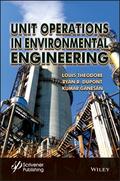Unit Operations in Environmental Engineering

1. Edition October 2017
702 Pages, Hardcover
Wiley & Sons Ltd
The book presents the principles of unit operations as well as the application of these principles to real-world problems.
The authors have written a practical introductory text exploring the theory and applications of unit operations for environmental engineers that is a comprehensive update to Linvil Rich's 1961 classic work, "Unit Operations in Sanitary Engineering". The book is designed to serve as a training tool for those individuals pursuing degrees that include courses on unit operations. Although the literature is inundated with publications in this area emphasizing theory and theoretical derivations, the goal of this book is to present the subject from a strictly pragmatic introductory point-of-view, particularly for those individuals involved with environmental engineering.
This book is concerned with unit operations, fluid flow, heat transfer, and mass transfer. Unit operations, by definition, are physical processes although there are some that include chemical and biological reactions. The unit operations approach allows both the practicing engineer and student to compartmentalize the various operations that constitute a process, and emphasizes introductory engineering principles so that the reader can then satisfactorily predict the performance of the various unit operations equipment.
"This is a definitive work on Unit Operations, one of the most important subjects in environmental engineering today. It is an excellent reference, well written, easily read and comprehensive. I believe the book will serve well those working in engineering disciplines including those beyond just environmental and chemical engineering. Bottom-line: A must for any technical library".
--Kenneth J. Skipka, CCM
Introduction xvii
Part I: Introduction to Principles of Unit Operations 1
1 History of Chemical Engineering and Unit Operations 3
2 Transport Phenomena versus the Unit Operations Approach 7
3 The Conservation Laws and Stoichiometry 11
4 The Ideal Gas Law 19
5 Thermodynamics 27
6 Chemical Kinetics 39
7 Equilibrium versus Rate Considerations 51
8 Process and Plant Design 57
Part II: Fluid Flow 69
9 Fluid Behavior 71
10 Basic Energy Conservation Laws 81
11 Law of Hydrostatics 89
12 Flow Measurement 95
13 Flow Classification 107
14 Prime Movers 121
15 Valves and Fittings 135
16 Air Pollution Control Equipment 145
17 Sedimentation, Centrifugation, and Flotation 157
18 Porous Media and Packed Beds 171
19 Filtration 181
20 Fluidization 193
21 Membrane Technology 205
22 Compressible and Sonic Flow 219
23 Two-Phase Flow 225
24 Ventilation 237
25 Mixing 247
26 Biomedical Engineering 253
Part III: Heat Transfer 265
27 Steady-State Conduction 267
28 Unsteady-State Conduction 275
29 Forced Convection 281
30 Free Convection 289
31 Radiation 299
32 The Heat Transfer Equation 311
33 Double Pipe Heat Exchangers 325
34 Shell and Tube Heat Exchangers 337
35 Finned Heat Exchangers 347
36 Other Heat Transfer Equipment 357
37 Insulation and Refractory 369
38 Refrigeration and Cryogenics 375
39 Condensation and Boiling 391
40 Operation, Maintenance, and Inspection (OM&I) 403
41 Design Principles 411
Part IV: Mass Transfer 419
42 Equilibrium Principles 421
43 Phase Equilibrium Relationships 429
44 Rate Principles 443
45 Mass Transfer Coefficients 453
46 Classification of Mass Transfer Operations 465
47 Characteristics of Mass Transfer Operations 473
48 Absorption and Stripping 485
49 Distillation 495
50 Adsorption 505
51 Liquid-Liquid and Solid-Liquid Extraction 517
52 Humidification 529
53 Drying 543
54 Absorber Design and Performance Equations 555
55 Distillation Design and Performance Equations 571
56 Adsorber Design and Performance Equations 589
57 Crystallization 597
58 Other and Novel Separation Processes 609
Part V: Case Studies 615
59 Drag Force Coefficient Correlation 617
60 Predicting Pressure Drop with Pipe Failure for Flow through Parallel Pipes 621
61 Developing an Improved Model to Describe the Cunningham Correction Factor Effect 623
62 Including Entropy Analysis in Heat Exchange Design 625
63 Predicting Inside Heat Transfer Coefficients in Double-Pipe Exchangers 629
64 Converting View Factor Graphical Data to Equation Form 631
65 Correcting a Faulty Absorber Design 633
66 A Unique Liquid-Liquid Extraction Unit 635
67 Effect of Plate Failure on Distillation Column Performer 639
Appendix A: Units 641
Appendix B: Miscellaneous Tables 649
Appendix C: Steam Tables 653
Appendix D: Basic Calculations 663
R. Ryan Dupont has more than 35 years of experience teaching and conducting applied and basic research in environmental engineering at the Utah Water Research Laboratory at Utah State University. He received his PhD degrees in Environmental Health Engineering from the University of Kansas, Lawrence and has been a Professor of Civil and Environmental Engineering at USU since 1995, serving as the Head of the Environmental Engineering Division for 10 years. He was a 2015 National Air and Waste Management Association Richard I. Stessel Waste Management Award winner for excellence in Waste Management Education.
Kumar Ganesan is currently a professor and department head of the Department of Environmental Engineering at Montana Tech where he has been for the past 35 years. He received his PhD from Washington State University at Pullman, Washington in Engineering Science. His current research includes developing bio-fiber based metallic nanoparticle filters to remove toxic metals from air and water.


